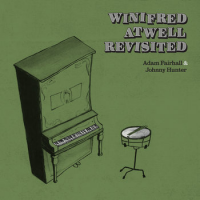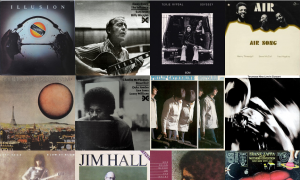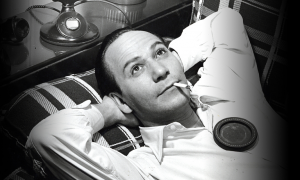Home » Jazz Articles » Top Ten List » Pat Martino Top Ten Albums: More Than Meets The Eye
Pat Martino Top Ten Albums: More Than Meets The Eye
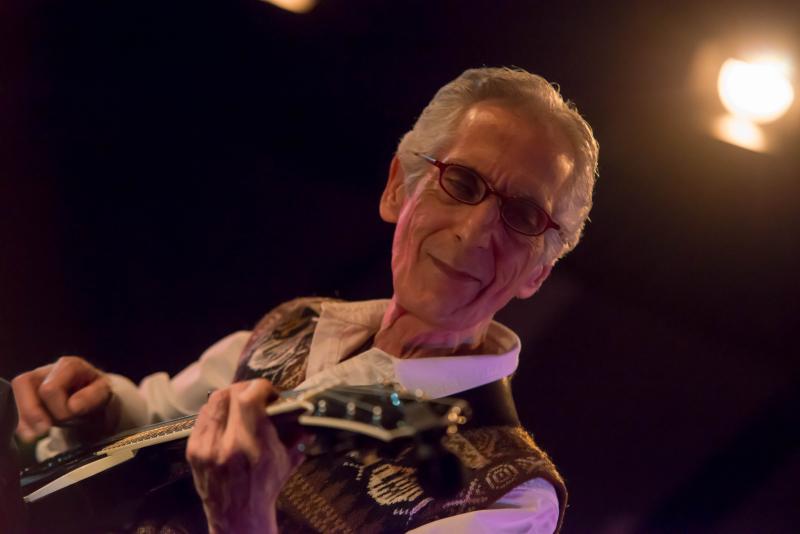
Courtesy John Kelman
In a sixty-year career, interrupted for the guts of a decade by a near fatal brain aneurysm—see Ian Knox's documentary Martino Unstrung (Sixteen Films, 2008)—Martino recorded twenty-seven albums as leader for labels such as Prestige, Muse, Warner Bros. and Blue Note.
There were also over fifty outings as a sideman with Richard "Groove" Holmes, John Handy, Sonny Stitt, Jimmy Heath, Woody Herman, Stanley Clarke, and Joey DeFrancesco, amongst others.
Steeped in the tradition of Wes Montgomery, bebop, soul-jazz and blues, there was nevertheless an adventurous side to Martino that saw him experiment, to greater or lesser extent, throughout much of his career. The following Top Ten, subjective as such lists tend to be, reflects the diversity of Martino's output.
 El Hombre
El HombrePrestige
1967
Pat Martino's debut recording as leader was, in fact, his second. A year before, in 1966, Martino had recorded an album for Vanguard Records with Ron Carter, Tommy Flanagan and Tony Williams. That album was shelved as the label instead pushed another recent signing, Larry Coryell, and the cans have remained buried somewhere to this day. In the preceding years Martino had appeared on around half a dozen Prestige sessions by the likes of Willis "Gator" Jackson, Jack McDuff, Don Patterson and Trudy Pitts. He made the jump to Prestige leader with this impressive soul-jazz organ trio outing featuring Pitts and drummer Mitch Fine.
A couple of months earlier, Martino had played on Pitts' own Prestige debut, Introducing the Fabulous Trudy Pitts (1967), and the Hammond B organist—a fellow Philadelphian—provides beautifully shimmering accompaniment throughout, displaying her own considerable chops on the smoking "A Blues For Mickey- O." Flautist Danny Turner weaves intricate unison lines with Martino and comes in to his own a couple of tracks, notably the boppish "One For Rose."
The session, however, is all about Martino, who wears his Wes Montgomery influence on his sleeve throughout, particularly on Antonio Carlos Jobim/Vinicius de Moraes's cool ballad "Once I Loved You," with added Latin percussion that borders on cheesy. There are any number of truly great Martino solos throughout this swinging straight-ahead session, but the twenty-two-year-old pulls absolutely no punches on "Waltz for Geri," soloing, in quite brilliant fashion, for the song's entire six minutes. An auspicious debut that announced the arrival of a great talent and a distinctive voice
 Baiyina (The Clear Evidence)
Baiyina (The Clear Evidence)Prestige
1968
After a slew of albums in the Hammond B, jazz-soul vein, including half a dozen with Jack McDuff, Martino admitted that he had grown tired of the format by the end of the '60s. Experimentation was the order of the day. If Wes Montgomery had influenced El Hombre, then the sounds of Jimi Hendrix, Ravi Shankar and the psychedelic culture all left their mark on Baiyina....
The album's subtitle, A Psychedlic Excursion through the Magical Mysteries of the Koran, reflected the widespread interest in spiritualism and Eastern philosophies so prevalent in those times, though the not unrelated musical imprints of John Coltrane and Miles Davis are also present here. Tanpura player Khalil Balakrishna—who would play sitar on Davis' Bitches Brew (Columbia, 1970) sessions less than a year later—lays a drone throughout the album's four tracks, while Richard Davis's bass ostinatos and Charlie Persip's cantering cymbals forge mantra-like grooves and meditative waves. Reggie Ferguson's tabla is a quietly percolating constant, as are guitarist Bobby Rose's repetitive riffs, which run through this modal music like a chant.
As for Martino, he navigates the unusual time signatures with attacking lines that owe more to Coltrane and Shankar than Wes Montgomery. Gregory Herbert also channels his inner Coltrane on alto saxophone on the fifteen-minute "Distant Land," though brings a more personal touch on flute to "Where Love's a Grown Up God" as well as the hypnotic title track.
At the time, Downbeat's Leonard Feather awarded Baiyina a five-star review. It is possible that the estimable jazz critic was also on LSD at the time as Baiyina is far from a masterpiece. It is, however, a fascinating insight into Martino's evolution and stands as a unique entry in his discography.
 Desperado
DesperadoPrestige
1970
Almost two years passed between Baiyina and Martino's next album, Desperado, which might not seem like a long time, but in the interim Martino's sound had developed more avant-garde leanings. Playing twelve-string guitar throughout, Martino is joined by Tyrone Brown on electric bass, Eddie Green on electric piano and the effervescent Sherman Ferguson on drums—all of whom would soon play in the jazz-fusion outfit Catalyst.
Martino's inventiveness, which seems inexhaustible, is heard to great effect on the ripping jazz funk of "Blackjack," where he solos for five mazy minutes. Another doozy on the bluesy "Dearborn Walk" and a breathless romp through Sonny Rollins' "Oleo" show that Martino hasn't severed links with his roots, but this is modern jazz guitar at its most progressive, paving the way for and inspiring the likes of John Scofield, Emily Remler, Bobby Broom, Fareed Haque, Trey Anastasio... and countless others who followed in his wake.
Though Martino's soloing has the energy of rock, the language is unmistakably jazz, with a clear melodic logic. There is also a gentler side to his playing, as witnessed on the caressing ballad "A Portrait of Diana." "Express " caps an excellent album on a thrilling note, with visceral solos from Martino and Green.
 Pat Martino Live!
Pat Martino Live!Muse
1974
There are only a handful of live recordings of Pat Martino, but this one from late '72—and his first as leader—is arguably the best. Leading up to the gig in at Fair City, New York, Martino, organist Ron Thomas and drummer Sherman Ferguson had played a heap of engagements around town with various bassists. For this recorded gig Martino's regular bassist, Tyrone Brown, made the date. The quartet's chemistry is pronounced.
By this point Martino had a reputation as one of the hottest guitarists around, and the good and the great turned up that night to see him, including Ornette Coleman, George Benson and Chuck Loeb. The quartet is on fire on a charging, seventeen-minute version of "Special Door," where Martino drags bebop kicking and screaming into funk and avant-garde territory. Even when really attacking the music, however, Martino's warmth of tone, his rhythmic pulse, swing feel and melodicism are ever present.
There's no letting up in intensity on "The Great Stream," an apt title for Martino's relentless torrent of creativity, though there is also room for a fine solo from Thomas. A brilliant interpretation of Bobby Hebb's "Sunny" draws applause mid-solo as Martino pulls out all the stops in a bravura performance.
At just thirty-eight minutes long, there has to be more of this concert gathering dust in a can somewhere. If Willis "Gator" Jackson could release four live albums—all featuring Martino—from one 1964 gig, then Savoy Jazz, who bought the Muse catalog in 2003, could do us all a favor with a second helping from this electrifying gig.
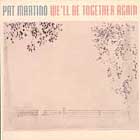 We'll Be Together Again
We'll Be Together Again Warner Bros.
1976
Martino was in the studio a lot in 1976, cutting no fewer than four albums, although Joyous Lake (Warner Bros) wouldn't be released until 1977. On February 10th '76, Martino recorded the quartet outing Exit (Muse) with pianist Gil Goldstein, bassist Richard Davis and drummer Billy Hart. Less than a week later Martino was back in the studio with just Goldstein, whose Fender Rhodes arrangements contribute significantly to the charm of Martino's first duo recording. The decision to use an electric piano seems like an inspired choice, but in fact, Goldstein's switch was simply due to the fact that the studio piano was deemed unfit for purpose.
Goldstein's orchestral colors are the perfect foil for Martino, who is in quietly inspired form. The fifteen-minute suite "Open Road (Olee / Variations and Song / Open Road)" is an arresting union of Goldstein's bright chordal voicings and Martino's fluid, ever lyrical responses. The feel throughout, however, is aid back, with Martino's beautifully tender yet warm playing on Henry Mancini's sensual ballad "Dreamsville," a selection likely inspired by Wes Montgomery's 1963 version that featured minimalist organ comping from Melvin Rhyne.
Other highlights include "Lament," with Martino flitting effortlessly between bluesy restraint and darting runs, a gorgeous reading of "You Don't Know What Love Is" and a gently bluesy interpretation of the old chestnut "Willow Weep for Me." Goldstein takes a couple of brief solos, but his remit is chiefly one of supporting Martino in what amounts to arguably the most sensitive and moving playing of the guitarist's entire recorded oeuvre.
 Joyous Lake
Joyous LakeWarner Bros.
1977
Martino's fusion outing Joyous Lake seemed to signal a new direction for the guitarist, though Starbright, (Warner Bros, 1976) with its eclectic mixture of styles ranging from rock to balladry and from post-bop and jazz-funk/fusion to acoustic, Shakti-influenced music, had already indicated a restlessness to explore new terrain. Joyous Lake is a more cohesive album stylistically, with Martino joined by brilliant young Berklee graduates, Delmar Brown on electric keyboards, Mark Leonard on electric bass and Kenwood Dennard on drums.
Pacy and intricate, there are shades of Weather Report on "Line Games" and the title track, while "M'Wandishi" clearly owes a debt to Herbie Hancock's Headhunters. The group interplay is tight and the soloing exhilarating, with Martino in exceptional, bebop-inspired form. Yet there is a melodicism within these grooves that seems to foreshadow the Pat Metheny Group. Curiously enough, Lyle Mays (of PMG fame) had been one of the musicians auditioned for this project.
The touring life of this exciting band was curtailed as Martino began to suffer severe headaches and, on one occassion, a seizure mid-performance—early warning signs of the trouble that lay ahead. But the record has stood the test of time, and for jazz-fusion fans anyway, it ranks as one of Martino's best.
 Stone Blue
Stone BlueBlue Note
1998
After another lengthy hiatus from the studio Martino recorded three albums in 1994 of mostly post-bop fare and ballads. All Sides Now (Blue Note, 1997) brought Martino together with a plethora of note-worthy guitarists, but that disjointed album, and the somewhat awkward sounding Indo-jazz outing Fire Dance (Mythos, 1997) (with Zakir Hussain, sitarist Habib Khan and flautist Peter Block) were both less than the sum of their parts.
Perhaps the most satisfying recording of all Martino's '90s output is Stone Blue, a very urbane album that sounds unlike anything he had done before. Twenty-two years after Joyous Lake Martino is reunited with drummer Kenwood Dennard and keyboardist Delmar Brown, who form a potent rhythm section with the brilliant electric bassist James Genus, on mostly up-tempo tunes. Martino and saxophonist Eric Alexander toggle between tight unison lines and flowing solos.
There's much to enjoy here, from the racing bop of "Uptown Down" and the slow-burning funk of "Stone Blue" to the breezy, George Benson- esque fare of "With All the People." Martino dials it down on the delicate ballad "Never Say Goodbye," a heartfelt tribute to guitarist Michael Hedges who had died in an accident shortly before this studio date.
Martino tips a wink to his early days in the Hammond organ outfits led by Jack McDuff and Don Patterson on the walking blues "13 to Go" and the funky "Mac Tough" and revisits "Joyous Lake." Throughout, Martino's playing, which is a tad more economical than in the old days, is fluid, soulful and persuasive. Above all, however, this is a strong group effort and one of Martino's personal favourites.
 Live at Yoshi's
Live at Yoshi'sBlue Note
2001
Even before recording with the organ combos of Willis 'Gator' Jackson and Jack McDuff, Martino had played with Philadelphian organist Charles Earland. Earland passed away in 1999, so Live at Yoshi's, Martino's first organ trio album in over thirty years, was really the guitarist's tribute to his old friend. With Joey DeFrancesco in the organ seat and Billy Hart on drums, the trio went on the road rather than rehearse in a studio, culminating in three nights at Yoshi's in December 2000.
The format, as is generally the case with such combos, is unwavering, with Martino and Francesco alternating solos on every track, but the quality of the playing and the chemistry of the trio is terrific. Earland was nicknamed "The Mighty Burner" and DeFrancesco certainly steps into those shoes with sizzling performances on the bop-oriented tunes such as Sonny Rollins' "Oleo" and Martino's "Catch."
Martino seems inspired by DeFrancesco's fire, but the duo is at its most seductive on slower, brushes-steered fare, with the walking blues "All Blues," an especially tender version of "Blue in Green" and Martino's soulful ballad "Walking to A Prayer" serving up some special moments. The enthusiasm of the crowd contributes greatly to the atmosphere on what proved to be one of Martino's best sellers for years.
 Nexus
Nexus HighNote Records
2016
Only the second duo album by Pat Martino, this live recording with keyboardist Jim Ridl, at Tin Angel, Philadelphia, hails from an unspecified date in the mid-'90s. Whilst the historical details may be murky, what is crystal clear is the empathy between the two musicians. Martino had come across Ridl playing in a Phily bar in late '92, and impressed, recruited him for Interchange (Muse, 1994). Their association, which Martino described as "especially rewarding" in his autobiography Here And Now! (Backbeat Books, 2011), would last for a decade.
Martino's playing on up-tempo numbers "Recollection" and Sonny Rollins' "Oleo" is fluid but focused, with the helter skelter speed of his early years slightly tempered. The guitarist's comping is also more pronounced than previously, seemingly compensating for Ridl's sparing use of his left-hand as a rhythmic tool. The balance between the duo is finely poised between support and coaxing, producing a dialogue that is warm, intuitive and engaging. Ridl described Martino as "an old soul" and certainly the guitarist's beautiful playing on the ballads "Sun on my Hands," his own "Country Road" and a tender reading of John Coltrane's "Naima" are as good as anything he committed to record.
 Formidable
FormidableHighnote Records
2017
As it began with an organ combo, so too it ended. Fifty years after El Hombre, Martino took to the studio for what would be the final time, augmenting his latter-day organ trio of Pat Bianchi and Carmen Intorre Jr. with tenor saxophonist Adam Niewood and trumpeter Alex Norris Jr. Niewood and Norris Jr. contribute soulful heads and a smattering of solos on what is the only Martino recording to feature this instrumentation.
Whilst the palette may be enlarged, Martino sticks to what he knows best on this set of blues-based swing numbers, arresting ballads and post-bop burners. The easy swinging grooves of Joey Calderazzo's "El Niño" and Hank Mobley's "Hipsippy Blues" invite relaxed, pristinely articulated solos from Martino, whose playing seems much more invested in conjuring mood and feeling than in any extravagant displays of technique.
The quintet does raise some steam on Martino's bop-influenced "On the Stairs," but the real keepers, as so often with Martino, are the ballads. On Charles Mingus' "Duke Ellington's Sound of Love," Dave Brubeck's "In Your Own Sweet Way" and Ellington's "In A Sentimental Mood," rustling brushes and simmering organ textures provide sotto voce context for Martino's wonderfully nuanced solos, with his six-minute excursion on the latter the gem in the crown.
Tags
PREVIOUS / NEXT
Support All About Jazz
 All About Jazz has been a pillar of jazz since 1995, championing it as an art form and, more importantly, supporting the musicians who make it. Our enduring commitment has made "AAJ" one of the most culturally important websites of its kind, read by hundreds of thousands of fans, musicians and industry figures every month.
All About Jazz has been a pillar of jazz since 1995, championing it as an art form and, more importantly, supporting the musicians who make it. Our enduring commitment has made "AAJ" one of the most culturally important websites of its kind, read by hundreds of thousands of fans, musicians and industry figures every month.




